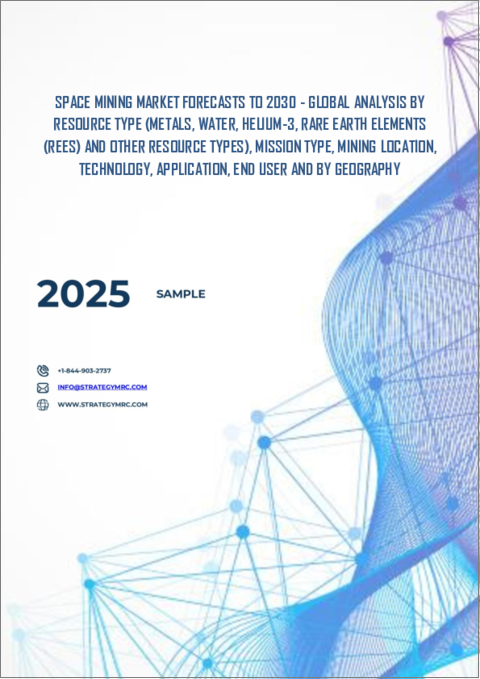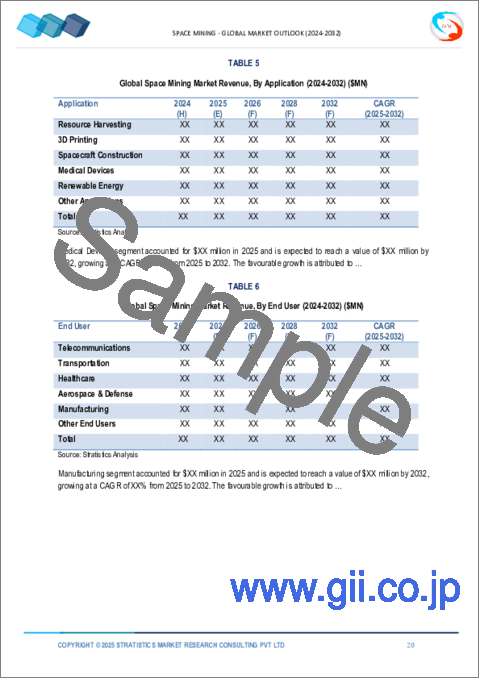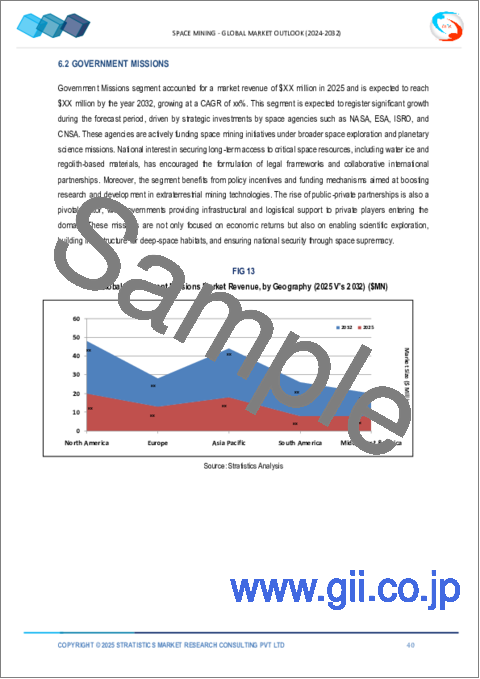|
|
市場調査レポート
商品コード
1625220
宇宙採掘市場の2030年までの予測: 資源タイプ別、ミッションタイプ別、採掘場所別、技術別、用途別、エンドユーザー別、地域別の世界分析Space Mining Market Forecasts to 2030 - Global Analysis By Resource Type (Metals, Water, Helium-3, Rare Earth Elements (REEs) and Other Resource Types), Mission Type, Mining Location, Technology, Application, End User and By Geography |
||||||
カスタマイズ可能
|
|||||||
| 宇宙採掘市場の2030年までの予測: 資源タイプ別、ミッションタイプ別、採掘場所別、技術別、用途別、エンドユーザー別、地域別の世界分析 |
|
出版日: 2025年01月01日
発行: Stratistics Market Research Consulting
ページ情報: 英文 200+ Pages
納期: 2~3営業日
|
全表示
- 概要
- 図表
- 目次
Stratistics MRCによると、世界の宇宙採掘市場は2024年に19億米ドルを占め、予測期間中のCAGRは20.1%で成長し、2030年には57億米ドルに達すると予想されています。
宇宙採掘とは、小惑星、月、その他の天体から金属、鉱物、水などの貴重な資源を抽出することです。主な目的は、プラチナ、金、希土類元素など、地球上では希少な物質を集めることです。宇宙採掘は、宇宙船の建造、生命の維持、宇宙ミッションの燃料として不可欠な資源を提供することで、将来の宇宙探査を支える可能性を秘めています。
2024年の欧州宇宙機関(ESA)の評価によると、宇宙採掘に必要な技術のうち、現在、宇宙用途の最低水準である技術準備レベル(TRL)6以上に達しているのは約30%に過ぎません。
高付加価値資源の可能性の高まり
技術の進歩と投資の増加により、小惑星やその他の天体から貴金属、水、希少鉱物などの高価値資源の抽出が促進され、市場は大きく成長する態勢にあります。この新興産業は資源調達に革命をもたらし、地球上の供給制約を緩和する可能性があります。宇宙探査が拡大するにつれて、宇宙ミッションと地上産業の両方に不可欠なこれらの資源の需要が急増し、莫大な経済的可能性が生まれると予想されます。
宇宙で採掘される物質の明確な市場の欠如
宇宙で採掘された材料の明確な市場がないことは、市場にとって大きな課題です。レアメタルのような資源に対する確立された需要メカニズムや価格メカニズムがなければ、企業は不確実性と財務リスクに直面します。これは投資を妨げ、技術進歩を遅らせ、探査意欲を減退させます。さらに、市場が明確でないことは、非効率的な生産と商業化につながり、この分野の成長と世界の産業にとっての潜在的利益を停滞させる可能性があります。
宇宙旅行と宇宙の商業化
宇宙観光と宇宙の商業化が市場の成長を牽引しています。民間会社が宇宙観光に乗り出すにつれて、レアメタルや鉱物などの資源の需要が高まり、小惑星採掘への関心が高まっています。この新興市場は、地球外での資源採掘の機会を提供し、技術、製造、インフラに貴重な材料を新たに供給することで産業を再編成する可能性があると同時に、商業的宇宙探査を拡大します。
スペースデブリのリスク
スペースデブリのリスクは、市場に大きな脅威をもたらします。採掘事業が拡大するにつれて、デブリがより多く発生する可能性があります。デブリは衛星や宇宙船に衝突する可能性があり、損害を与えて事業を中断させます。そのため、保険や安全対策、デブリ除去技術の開発などにかかるコストが増大します。また、宇宙ゴミの蓄積によって採掘場へのアクセスが制限され、産業の成長と持続可能性が妨げられる可能性もあります。
COVID-19の影響:
COVID-19パンデミックは市場に大きな影響を与え、労働力の途絶とサプライチェーンの課題により、研究開発および打ち上げの遅れを引き起こしました。また、投資家がより差し迫った問題に集中したため、宇宙開発プロジェクトに対する資金調達も鈍化しました。さらに、世界の景気後退により、政府および民間部門の宇宙開発予算が減少しました。こうした挫折は、宇宙採掘技術と商業ベンチャーの進展を遅らせ、業界の成長を鈍化させました。
予測期間中、小惑星セグメントが最大になると予想される
小惑星セグメントは、レアメタル、水、その他の鉱物などの貴重な資源に富んでいるため、予測期間中に最大の市場シェアを占めると予想されます。これらの天体は資源採掘の大きな可能性を提供し、地球上や宇宙ベースの産業で使用する材料を供給する可能性があります。小惑星を採掘することで、地上資源への依存を減らし、長期的な宇宙探査をサポートすることができますが、効率的で費用対効果の高い採掘事業を開発するには、技術的・財政的課題が残っています。
予測期間中、通信分野のCAGRが最も高くなると予想されます。
通信分野は、予測期間中のCAGRが最も高くなると予想されます。高度な通信システムは、採掘宇宙船、地球上の制御センター、その他の宇宙資産間のシームレスな接続を保証します。この技術は、小惑星採掘の複雑さを管理し、資源抽出を最適化し、安全性と効率性を確保するために不可欠であると同時に、宇宙探査と商業化に必要な広範なインフラをサポートします。
最大のシェアを占める地域
北米地域は、政府機関と非公開会社の両方からの多額の投資により、予測期間中最大の市場シェアを占めると予測されています。同地域は、小惑星探査と資源抽出を中心とした宇宙採掘技術開発のリーダーです。この地域の強固な航空宇宙産業、先進的な研究インフラ、規制の枠組みは、宇宙採掘ベンチャーの商業化と拡大のための強力な基盤を提供しています。
CAGRが最も高い地域:
予測期間中、アジア太平洋地域が最も高い成長率を記録すると予想されます。自律採掘技術、宇宙ロボット工学、推進システム、天体からの資源抽出のための効率的な方法の開発が主要な推進力となります。しかしながら、宇宙採掘は莫大な経済的機会を提供する可能性があります。プラチナ、金、希土類元素、(燃料や生命維持のための)水などの貴重な物質は、宇宙、特に小惑星に豊富に存在します。
無料カスタマイズサービス:
本レポートをご購読のお客様には、以下の無料カスタマイズ・オプションのいずれかをご提供いたします:
- 企業プロファイル
- 追加市場プレーヤーの包括的プロファイリング(3社まで)
- 主要企業のSWOT分析(3社まで)
- 地域セグメンテーション
- 顧客の関心に応じた主要国の市場推計・予測・CAGR(注:フィージビリティチェックによる)
- 競合ベンチマーキング
- 製品ポートフォリオ、地理的プレゼンス、戦略的提携に基づく主要企業のベンチマーキング
目次
第1章 エグゼクティブサマリー
第2章 序文
- 概要
- ステークホルダー
- 調査範囲
- 調査手法
- データマイニング
- データ分析
- データ検証
- 調査アプローチ
- 調査情報源
- 1次調査情報源
- 2次調査情報源
- 前提条件
第3章 市場動向分析
- 促進要因
- 抑制要因
- 機会
- 脅威
- 技術分析
- 用途分析
- エンドユーザー分析
- 新興市場
- COVID-19の影響
第4章 ポーターのファイブフォース分析
- 供給企業の交渉力
- 買い手の交渉力
- 代替品の脅威
- 新規参入業者の脅威
- 競争企業間の敵対関係
第5章 世界の宇宙採掘市場:資源タイプ別
- 金属
- 水
- ヘリウム3
- 希土類元素(REE)
- その他のリソースタイプ
第6章 世界の宇宙採掘市場:ミッションタイプ別
- 政府ミッション
- 民間セクターミッション
- 共同ミッション
第7章 世界の宇宙採掘市場:採掘場所別
- 小惑星
- 月
- 火星
- 彗星
第8章 世界の宇宙採掘市場:技術別
- ロボット工学と自動化
- 3Dプリンティング
- 宇宙ドローン
- 採掘設備
第9章 世界の宇宙採掘市場:用途別
- 資源の採取
- 3Dプリンティング
- 宇宙船の建造
- 医療機器
- 再生可能エネルギー
- その他の用途
第10章 世界の宇宙採掘市場:エンドユーザー別
- 通信
- 交通機関
- ヘルスケア
- 航空宇宙および防衛
- 製造業
- その他のエンドユーザー
第11章 世界の宇宙採掘市場:地域別
- 北米
- 米国
- カナダ
- メキシコ
- 欧州
- ドイツ
- 英国
- イタリア
- フランス
- スペイン
- その他欧州
- アジア太平洋
- 日本
- 中国
- インド
- オーストラリア
- ニュージーランド
- 韓国
- その他アジア太平洋地域
- 南米
- アルゼンチン
- ブラジル
- チリ
- その他南米
- 中東・アフリカ
- サウジアラビア
- アラブ首長国連邦
- カタール
- 南アフリカ
- その他中東とアフリカ
第12章 主な発展
- 契約、パートナーシップ、コラボレーション、合弁事業
- 買収と合併
- 新製品発売
- 事業拡大
- その他の主要戦略
第13章 企業プロファイリング
- Planetary Resources
- Deep Space Industries(DSI)
- Blue Origin
- SpaceX
- Astrobotic Technology
- Moon Express
- Sierra Nevada Corporation
- TransAstra Corporation
- Lunar Outpost
- Maxar Technologies
- AstroScale
- Relativity Space
- Interstellar Technologies
- NASA(National Aeronautics and Space Administration)
- Bluebird International
List of Tables
- Table 1 Global Space Mining Market Outlook, By Region (2022-2030) ($MN)
- Table 2 Global Space Mining Market Outlook, By Resource Type (2022-2030) ($MN)
- Table 3 Global Space Mining Market Outlook, By Metals (2022-2030) ($MN)
- Table 4 Global Space Mining Market Outlook, By Water (2022-2030) ($MN)
- Table 5 Global Space Mining Market Outlook, By Helium-3 (2022-2030) ($MN)
- Table 6 Global Space Mining Market Outlook, By Rare Earth Elements (REEs) (2022-2030) ($MN)
- Table 7 Global Space Mining Market Outlook, By Other Resource Types (2022-2030) ($MN)
- Table 8 Global Space Mining Market Outlook, By Mission Type (2022-2030) ($MN)
- Table 9 Global Space Mining Market Outlook, By Government Missions (2022-2030) ($MN)
- Table 10 Global Space Mining Market Outlook, By Private Sector Missions (2022-2030) ($MN)
- Table 11 Global Space Mining Market Outlook, By Collaborative Missions (2022-2030) ($MN)
- Table 12 Global Space Mining Market Outlook, By Mining Location (2022-2030) ($MN)
- Table 13 Global Space Mining Market Outlook, By Asteroids (2022-2030) ($MN)
- Table 14 Global Space Mining Market Outlook, By Moon (2022-2030) ($MN)
- Table 15 Global Space Mining Market Outlook, By Mars (2022-2030) ($MN)
- Table 16 Global Space Mining Market Outlook, By Comets (2022-2030) ($MN)
- Table 17 Global Space Mining Market Outlook, By Technology (2022-2030) ($MN)
- Table 18 Global Space Mining Market Outlook, By Robotics & Automation (2022-2030) ($MN)
- Table 19 Global Space Mining Market Outlook, By 3D Printing (2022-2030) ($MN)
- Table 20 Global Space Mining Market Outlook, By Space Drones (2022-2030) ($MN)
- Table 21 Global Space Mining Market Outlook, By Mining Equipment (2022-2030) ($MN)
- Table 22 Global Space Mining Market Outlook, By Application (2022-2030) ($MN)
- Table 23 Global Space Mining Market Outlook, By Resource Harvesting (2022-2030) ($MN)
- Table 24 Global Space Mining Market Outlook, By 3D Printing (2022-2030) ($MN)
- Table 25 Global Space Mining Market Outlook, By Spacecraft Construction (2022-2030) ($MN)
- Table 26 Global Space Mining Market Outlook, By Medical Devices (2022-2030) ($MN)
- Table 27 Global Space Mining Market Outlook, By Renewable Energy (2022-2030) ($MN)
- Table 28 Global Space Mining Market Outlook, By Other Applications (2022-2030) ($MN)
- Table 29 Global Space Mining Market Outlook, By End User (2022-2030) ($MN)
- Table 30 Global Space Mining Market Outlook, By Telecommunications (2022-2030) ($MN)
- Table 31 Global Space Mining Market Outlook, By Transportation (2022-2030) ($MN)
- Table 32 Global Space Mining Market Outlook, By Healthcare (2022-2030) ($MN)
- Table 33 Global Space Mining Market Outlook, By Aerospace & Defense (2022-2030) ($MN)
- Table 34 Global Space Mining Market Outlook, By Manufacturing (2022-2030) ($MN)
- Table 35 Global Space Mining Market Outlook, By Other End Users (2022-2030) ($MN)
Note: Tables for North America, Europe, APAC, South America, and Middle East & Africa Regions are also represented in the same manner as above.
According to Stratistics MRC, the Global Space Mining Market is accounted for $1.9 billion in 2024 and is expected to reach $5.7 billion by 2030 growing at a CAGR of 20.1% during the forecast period. Space mining is the extraction of valuable resources, such as metals, minerals, and water, from asteroids, moons, and other celestial bodies. The primary goal is to gather rare materials like platinum, gold, and rare earth elements that are scarce on Earth. Space mining holds the potential to support future space exploration by providing essential resources for building spacecraft, sustaining life, and fueling space missions.
According to a 2024 European Space Agency (ESA) assessment, only around 30% of the technologies required for space mining are currently at a Technology Readiness Level (TRL) of 6 or higher, the minimum for space applications.
Market Dynamics:
Driver:
Growing potential for high-value resources
The market is poised for significant growth as technological advancements and increased investment fuel the extraction of high-value resources like precious metals, water, and rare minerals from asteroids and other celestial bodies. This emerging industry promises to revolutionize resource sourcing, potentially alleviating supply constraints on Earth. As space exploration expands, the demand for these resources, essential for both space missions and terrestrial industries, is expected to surge, creating immense economic potential.
Restraint:
Lack of a clear market for space-mined materials
The lack of a clear market for space-mined materials poses a significant challenge for the market. Without established demand or pricing mechanisms for resources like rare metals, companies face uncertainty and financial risks. This hampers investment, delays technological advancements, and reduces the incentive for exploration. Furthermore, the absence of market clarity can lead to inefficient production and commercialization, stalling the sector's growth and potential benefits for global industries.
Opportunity:
Space tourism and commercialization of space
Space tourism and the commercialization of space are driving the growth of the market. As private companies venture into space tourism, the demand for resources such as rare metals and minerals increases, sparking interest in asteroid mining. This emerging market presents opportunities for resource extraction beyond Earth, potentially reshaping industries by providing new supplies of precious materials for technology, manufacturing, and infrastructure, while also expanding commercial space exploration.
Threat:
Risk of space debris
The risk of space debris poses a significant threat to the market. As mining operations increase, so does the potential for generating more debris, which can collide with satellites and spacecraft, causing damage and disrupting operations. This increases costs for insurance, safety measures, and the development of debris removal technologies. The accumulation of space junk could also limit access to mining sites, hindering industry growth and sustainability.
Covid-19 Impact:
The COVID-19 pandemic had a significant impact on the market, causing delays in research, development, and launches due to workforce disruptions and supply chain challenges. Funding for space exploration projects also slowed as investors focused on more immediate concerns. Furthermore, the global economic downturn reduced government and private sector budgets for space ventures. These setbacks delayed the progress of space mining technologies and commercial ventures, slowing the industry's growth.
The asteroids segment is expected to be the largest during the forecast period
The asteroids segment is expected to account for the largest market share during the projection period as they are rich in valuable resources such as rare metals, water, and other minerals. These celestial bodies offer significant potential for resource extraction, which could supply materials for use on Earth and in space-based industries. Mining asteroids could reduce reliance on terrestrial resources and support long-term space exploration, but technological and financial challenges remain in developing efficient and cost-effective mining operations.
The telecommunications segment is expected to have the highest CAGR during the forecast period
The telecommunications segment is expected to have the highest CAGR during the extrapolated period. Advanced communication systems ensure seamless connectivity between mining spacecraft, Earth-based control centers, and other space assets. This technology is vital for managing the complexities of asteroid mining, optimizing resource extraction, and ensuring safety and efficiency, while also supporting the broader infrastructure needed for space exploration and commercialization.
Region with largest share:
North America region is projected to account for the largest market share during the forecast period driven by significant investments from both government agencies and private companies. The region is a leader in developing space mining technologies, focusing on asteroid exploration and resource extraction. The regions robust aerospace industry, advanced research infrastructure, and regulatory frameworks provide a strong foundation for the commercialization and expansion of space mining ventures.
Region with highest CAGR:
Asia Pacific is expected to register the highest growth rate over the forecast period. The development of autonomous mining technologies, space robotics, propulsion systems, and efficient methods for resource extraction from celestial bodies will be a key driver. Moroever, space mining could offer vast economic opportunities. Valuable materials such as platinum, gold, rare earth elements, and water (for fuel and life support) are in abundance in space, particularly in asteroids.
Key players in the market
Some of the key players in Space Mining market include Planetary Resources, Deep Space Industries (DSI), Blue Origin, SpaceX, Astrobotic Technology, Moon Express, Sierra Nevada Corporation, TransAstra Corporation, Lunar Outpost, Maxar Technologies, AstroScale, Relativity Space, Interstellar Technologies, NASA (National Aeronautics and Space Administration) and Bluebird International.
Key Developments:
In December 2024, Crayola, Space4All, Blue Origin's nonprofit Club for the Future and Kennedy Space Center Visitor Complex revealed a new collaboration to honor exceptional educators, increase awareness about the importance of creativity and innovation in space, and inspire students to pursue a future in space-related careers..
In August 2024, NASA and BP signed a Space Act Agreement to test new technologies on the moon and advance energy production. The new agreement will see BP collaborate with Nasa "on a variety of technologies, such as digital models and simulations that allow engineers and scientists to visualise equipment in remote locations more than 7,000 feet (2,133.6m) underwater or millions of miles away on another planet," according to BP.
Resource Types Covered:
- Metals
- Water
- Helium-3
- Rare Earth Elements (REEs)
- Other Resource Types
Mission Types Covered:
- Government Missions
- Private Sector Missions
- Collaborative Missions
Mining Locations Covered:
- Asteroids
- Moon
- Mars
- Comets
Technologies Covered:
- Robotics & Automation
- 3D Printing
- Space Drones
- Mining Equipment
Applications Covered:
- Resource Harvesting
- 3D Printing
- Spacecraft Construction
- Medical Devices
- Renewable Energy
- Other Applications
End Users Covered:
- Telecommunications
- Transportation
- Healthcare
- Aerospace & Defense
- Manufacturing
- Other End Users
Regions Covered:
- North America
- US
- Canada
- Mexico
- Europe
- Germany
- UK
- Italy
- France
- Spain
- Rest of Europe
- Asia Pacific
- Japan
- China
- India
- Australia
- New Zealand
- South Korea
- Rest of Asia Pacific
- South America
- Argentina
- Brazil
- Chile
- Rest of South America
- Middle East & Africa
- Saudi Arabia
- UAE
- Qatar
- South Africa
- Rest of Middle East & Africa
What our report offers:
- Market share assessments for the regional and country-level segments
- Strategic recommendations for the new entrants
- Covers Market data for the years 2022, 2023, 2024, 2026, and 2030
- Market Trends (Drivers, Constraints, Opportunities, Threats, Challenges, Investment Opportunities, and recommendations)
- Strategic recommendations in key business segments based on the market estimations
- Competitive landscaping mapping the key common trends
- Company profiling with detailed strategies, financials, and recent developments
- Supply chain trends mapping the latest technological advancements
Free Customization Offerings:
All the customers of this report will be entitled to receive one of the following free customization options:
- Company Profiling
- Comprehensive profiling of additional market players (up to 3)
- SWOT Analysis of key players (up to 3)
- Regional Segmentation
- Market estimations, Forecasts and CAGR of any prominent country as per the client's interest (Note: Depends on feasibility check)
- Competitive Benchmarking
- Benchmarking of key players based on product portfolio, geographical presence, and strategic alliances
Table of Contents
1 Executive Summary
2 Preface
- 2.1 Abstract
- 2.2 Stake Holders
- 2.3 Research Scope
- 2.4 Research Methodology
- 2.4.1 Data Mining
- 2.4.2 Data Analysis
- 2.4.3 Data Validation
- 2.4.4 Research Approach
- 2.5 Research Sources
- 2.5.1 Primary Research Sources
- 2.5.2 Secondary Research Sources
- 2.5.3 Assumptions
3 Market Trend Analysis
- 3.1 Introduction
- 3.2 Drivers
- 3.3 Restraints
- 3.4 Opportunities
- 3.5 Threats
- 3.6 Technology Analysis
- 3.7 Application Analysis
- 3.8 End User Analysis
- 3.9 Emerging Markets
- 3.10 Impact of Covid-19
4 Porters Five Force Analysis
- 4.1 Bargaining power of suppliers
- 4.2 Bargaining power of buyers
- 4.3 Threat of substitutes
- 4.4 Threat of new entrants
- 4.5 Competitive rivalry
5 Global Space Mining Market, By Resource Type
- 5.1 Introduction
- 5.2 Metals
- 5.3 Water
- 5.4 Helium-3
- 5.5 Rare Earth Elements (REEs)
- 5.6 Other Resource Types
6 Global Space Mining Market, By Mission Type
- 6.1 Introduction
- 6.2 Government Missions
- 6.3 Private Sector Missions
- 6.4 Collaborative Missions
7 Global Space Mining Market, By Mining Location
- 7.1 Introduction
- 7.2 Asteroids
- 7.3 Moon
- 7.4 Mars
- 7.5 Comets
8 Global Space Mining Market, By Technology
- 8.1 Introduction
- 8.2 Robotics & Automation
- 8.3 3D Printing
- 8.4 Space Drones
- 8.5 Mining Equipment
9 Global Space Mining Market, By Application
- 9.1 Introduction
- 9.2 Resource Harvesting
- 9.3 3D Printing
- 9.4 Spacecraft Construction
- 9.5 Medical Devices
- 9.6 Renewable Energy
- 9.7 Other Applications
10 Global Space Mining Market, By End User
- 10.1 Introduction
- 10.2 Telecommunications
- 10.3 Transportation
- 10.4 Healthcare
- 10.5 Aerospace & Defense
- 10.6 Manufacturing
- 10.7 Other End Users
11 Global Space Mining Market, By Geography
- 11.1 Introduction
- 11.2 North America
- 11.2.1 US
- 11.2.2 Canada
- 11.2.3 Mexico
- 11.3 Europe
- 11.3.1 Germany
- 11.3.2 UK
- 11.3.3 Italy
- 11.3.4 France
- 11.3.5 Spain
- 11.3.6 Rest of Europe
- 11.4 Asia Pacific
- 11.4.1 Japan
- 11.4.2 China
- 11.4.3 India
- 11.4.4 Australia
- 11.4.5 New Zealand
- 11.4.6 South Korea
- 11.4.7 Rest of Asia Pacific
- 11.5 South America
- 11.5.1 Argentina
- 11.5.2 Brazil
- 11.5.3 Chile
- 11.5.4 Rest of South America
- 11.6 Middle East & Africa
- 11.6.1 Saudi Arabia
- 11.6.2 UAE
- 11.6.3 Qatar
- 11.6.4 South Africa
- 11.6.5 Rest of Middle East & Africa
12 Key Developments
- 12.1 Agreements, Partnerships, Collaborations and Joint Ventures
- 12.2 Acquisitions & Mergers
- 12.3 New Product Launch
- 12.4 Expansions
- 12.5 Other Key Strategies
13 Company Profiling
- 13.1 Planetary Resources
- 13.2 Deep Space Industries (DSI)
- 13.3 Blue Origin
- 13.4 SpaceX
- 13.5 Astrobotic Technology
- 13.6 Moon Express
- 13.7 Sierra Nevada Corporation
- 13.8 TransAstra Corporation
- 13.9 Lunar Outpost
- 13.10 Maxar Technologies
- 13.11 AstroScale
- 13.12 Relativity Space
- 13.13 Interstellar Technologies
- 13.14 NASA (National Aeronautics and Space Administration)
- 13.15 Bluebird International





